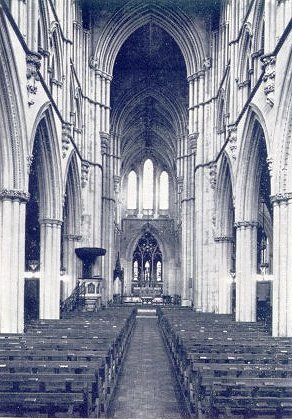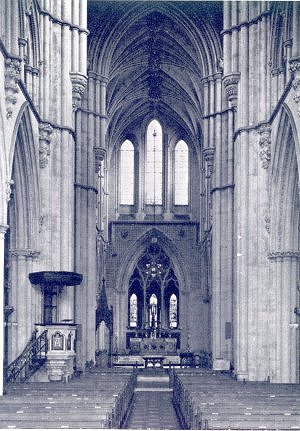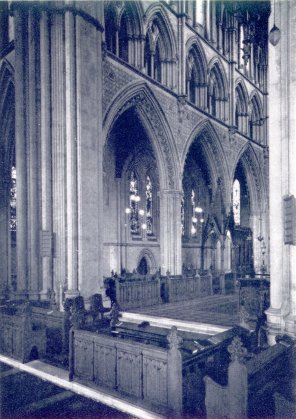We can do no better with regard to the actual Gordon Square church than to quote in full a letter to the author, written by the Anglican poet and architectural writer, John Betjeman [as he then was].
'I am so glad that you are being allowed to use the Catholic Apostolic Church in Gordon Square as a chapel for London University. Good heavens! You couldn't have a grander chapel. Why, even the nave of Westminster Abbey is only thirteen feet higher than the nave and sanctuary of Gordon Square. You have not got just a chapel for London University, but a cathedral.
'What I wanted to tell you was how splendid I think it as a building. As you know there was to be a spire 150 feet high over the tower crossing, and the nave was to extend two bays further west. This last would perfect the proportions of what is, without a doubt, the grandest church in London of the pioneer days of the Gothic Revival. We may be ahead of our time in seeing its beauty now (though its beauty ought to be obvious to anyone who isn't a silly prig mesmerised by dates and prejudiced against Victorian because he's afraid of being thought old-fashioned), but I'm quite sure that in ten years' time you will be thankful for having so magnificent and uplifting a building for worship.
| 'It isn't until you
are inside that you get its full grandeur. Its
architect, J. Raphael
Brandon, wrote
what is the standard work on Open Timber Roofs, and
another on Parish Churches (with his brother who died
in 1847, aged twentysix), and the famous Analysis
of Gothic Architecture. The Gordon Square church was started at a time (1853) when people were beginning to learn about mediaeval architecture thoroughly and systematically. As with the Roman and Greek orders - the last well displayed in Wilkins' design for London University in Gower Street - it was considered wrong to depart from precedent. You will therefore find in the Gordon Square church that Brandon did much careful copying of details from great abbeys (the Corbels at the tower crossing, by the way, were done by someone else in 1895, and very lively and rich they are), just as Wilkins copied from Greek details for his University Building. But you will find in Gordon Square the something extra which raises it out of mere copying into grand architecture - an over-all sense of proportion. Stand at the extreme west end and look east. Notice how the hammer-beam roof with its rich carving soars almost out of sight, becomes a stone-vaulted roof over the Sanctuary, and then leads the eye down the long-drawn vista to the pinnacled tabernacle, the personal gift of Brandon to the church, on the high altar. Beyond it, open tracery hints at the richest part of all the church, the apostles' chapel with its painted timber roof and deeply cut stone sedilia.' |
 |
| 'The broad Sanctuary
will give you a wide space for congregational and
eucharistic worship in which all can join. For daily
and smaller services there is the apostles' chapel,
and room for side chapels. Everywhere
vistas, everywhere dignity, and above all mystery -
Gordon Square church is solemn and suited to the
mystery of religion. It is built for worship not for
lectures. There is nothing shoddy or ill made
anywhere. All had to be of the best for the glory of
God and the Catholic Apostolic church members give a
tithe of their income to the church. The church was built for the noble ritual of the Catholic Apostolic Church which was a mixture of our own, the Roman Catholic, and the Orthodox liturgies. |
 |
| I remember the "Angel"
(Bishop) sitting in his canopied Throne by
the altar when the church was lit by gas and better
attended than it came to be. Do have a look at the
Catholic Apostolic Liturgy if you haven't done so
already. I am always sad that the Second Coming which the Catholic Apostolic church so ardently expects, has been so delayed that all the apostles who founded the church in 1835 are dead (the last died in 1901) and now all the angels are dead. The church still has adherents here and in North Germany and America, and it certainly had plenty of money, including that of the Drummonds and the Percys for building splendid churches of which your chapel to be and the Pearson Church on the canal in Maida Vale are the two best of the seven in London. I hope you will live to see the two bays added to the nave of Gordon Square church.' |
 |